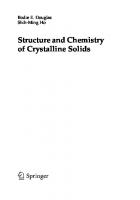The Electronic Structure and Chemistry Of Solids 0198552041, 9780198552048
478 109 17MB
English Pages [268] Year 1987
Table of contents :
Front Cover
Back Cover
Preface
Contents
A note on units
1. Introduction
1.1 The importance of solids
1.2 Chemical classification of solids
1.2.1 Molecular solids
1.2.2. Ionic solids
1.2.3 Covalent solids
1.2.4 Metallic solids
1.2.5 More complex solids
1.3 Electrons in solids
1.3.1 Orbitals in atoms, molecules, and solids
1.3.2 Bands and bonds
1.4 Metals, insulators, and semiconductors
1.4.1 Metallic and non-metallic solids
1.4.2 Thermal excitation of electrons
1.4.3 Semiconductors
Further reading
2. Spectroscopic methods
2.1 Introduction
2.2 Photoelectron spectroscopy (PES)
2.2.1 General principles
2.2.2 Applications of PES
2.2.3 Inverse PES
2.3 X-ray spectroscopy
2.3.1 General principles
2.3.2 Applications of X-ray emission spectroscopy (XES)
2.3.3 X-ray absorption spectroscopy (XAS)
2.4 Optical properties
2.4.1 Band gaps and excitions
2.4.2 Absorption and reflectivity
2.4.3 Metals - the plasma frequency
Further reading
3. Electronic energy levels and chemical bonding
3.1 Ionic solids
3.1.1 Sodium chloride - a typical example
3.1.2 General trends
3.1.3 Cations with filled d and s orbitals
3.2 Covalent solids
3.2.1 Elemental solids
3.2.2 Heteropolar bonding
3.2.3 Dielectric properties of binary compounds
3.3 Metals
3.3.1 Simple metals - the free electron model
3.3.2 Transition metals
3.4 Transition-metal compounds
3.4.1 The d band
3.4.2 Ligand field splittings
3.4.3 Metal-metal bonding in compounds
3.4.4 The failure of the band picture
Further reading
4. Elementary band theory
4.1 Crystal orbitals in one dimension
4.1.1 The importance of periodicity - Bloch functions
4.1.2 LCAO theory of the monatomic chain
4.1.3 The binary chain
4.1.4 The nearly-free electron model
4.1.5 The effective mass concept
4.1.6 Electronic conductivity
4.1.7 Band structure and spectroscopy
4.2 Two dimensions
4.2.1 LCAO theory of the square lattice
4.2.2 Nearly free electrons
4.2.3 The Hall effect
4.2.4 The electronic structure of graphite
4.2.5 Measurement of band structures by photoelectron spectroscopy
4.3 Three-dimensional band structures
4.3.1 Band structures of some simple solids
4.3.2 Metals and alloys
4.3.3 Chemical interpretations: orbital and overlap populations
Further reading
5. The effects of electron repulsion
5.1 The Hubbard model
5.2 Lanthanides
5.2.1 4f energies and the Hubbard U
5.2.2 Divalent compounds of lanthanides
5.3 Transition-metal compounds
5.3.1 Monoxides
5.3.2 General trends
5.3.3 Properties of localized electrons: ligand field effects
5.3.4 Magnetic properties of localized electrons
5.4 Other theories of interelectron repulsion
5.4.1 Wigner crystallization
5.4.2 The polarization catastrophe model
5.4.3 Metal-insulator transitions at high and low densities
Further reading
6. Lattice distortions
6.1 Low-dimensional solids
6.1.1 Periodic lattice distortions and charge density waves
6.1.2 Half-filled bands
6.1.3 Molecular metals
6.2 Polarons
6.2.1 Small and large polarons
6.2.2 Properties of small polarons
6.3 Mixed valency compounds
6.3.1 Classification of mixed valency compounds
6.3.2 Oxidation states differing by one
6.3.3 Oxidation states differing by two
Further reading
7. Defects, impurities, and surfaces
7.1 Structural and electronic classification of defects
7.1.1 Types of crystal defect
7.1.2 Electronic consequences of defects
7.2 Doped semiconductors
7.2.1 Donor and acceptor levels
7.2.2 Carrier concentrations and Fermi levels
7.2.3 Electronic properties
7.2.4 p-n junctions
7.2.5 Transition to the metallic state
7.3 Defects in ionic solids
7.3.1 F-centres in alkali halides
7.3.2 Semiconducting oxides
7.4 Highly disordered solids
7.4.1 Amorphous semiconductors
7.4.2 Anderson localization
7.5 Excited states
7.5.1 Excitons
7.5.2 Trapping of electrons and holes: luminescence
7.5.3 Chemical reactions of electrons and holes
7.6 Surfaces
7.6.1 The work function
7.6.2 Surface electronic states
7.6.3 Band bending at semiconductor surfaces
Further reading
Appendices
A: The Fermi-Dirac distribution function
B: Brillouin zones and the reciprocal lattice
Further reading
Chemical formula index
Subject index
Front Cover
Back Cover
Preface
Contents
A note on units
1. Introduction
1.1 The importance of solids
1.2 Chemical classification of solids
1.2.1 Molecular solids
1.2.2. Ionic solids
1.2.3 Covalent solids
1.2.4 Metallic solids
1.2.5 More complex solids
1.3 Electrons in solids
1.3.1 Orbitals in atoms, molecules, and solids
1.3.2 Bands and bonds
1.4 Metals, insulators, and semiconductors
1.4.1 Metallic and non-metallic solids
1.4.2 Thermal excitation of electrons
1.4.3 Semiconductors
Further reading
2. Spectroscopic methods
2.1 Introduction
2.2 Photoelectron spectroscopy (PES)
2.2.1 General principles
2.2.2 Applications of PES
2.2.3 Inverse PES
2.3 X-ray spectroscopy
2.3.1 General principles
2.3.2 Applications of X-ray emission spectroscopy (XES)
2.3.3 X-ray absorption spectroscopy (XAS)
2.4 Optical properties
2.4.1 Band gaps and excitions
2.4.2 Absorption and reflectivity
2.4.3 Metals - the plasma frequency
Further reading
3. Electronic energy levels and chemical bonding
3.1 Ionic solids
3.1.1 Sodium chloride - a typical example
3.1.2 General trends
3.1.3 Cations with filled d and s orbitals
3.2 Covalent solids
3.2.1 Elemental solids
3.2.2 Heteropolar bonding
3.2.3 Dielectric properties of binary compounds
3.3 Metals
3.3.1 Simple metals - the free electron model
3.3.2 Transition metals
3.4 Transition-metal compounds
3.4.1 The d band
3.4.2 Ligand field splittings
3.4.3 Metal-metal bonding in compounds
3.4.4 The failure of the band picture
Further reading
4. Elementary band theory
4.1 Crystal orbitals in one dimension
4.1.1 The importance of periodicity - Bloch functions
4.1.2 LCAO theory of the monatomic chain
4.1.3 The binary chain
4.1.4 The nearly-free electron model
4.1.5 The effective mass concept
4.1.6 Electronic conductivity
4.1.7 Band structure and spectroscopy
4.2 Two dimensions
4.2.1 LCAO theory of the square lattice
4.2.2 Nearly free electrons
4.2.3 The Hall effect
4.2.4 The electronic structure of graphite
4.2.5 Measurement of band structures by photoelectron spectroscopy
4.3 Three-dimensional band structures
4.3.1 Band structures of some simple solids
4.3.2 Metals and alloys
4.3.3 Chemical interpretations: orbital and overlap populations
Further reading
5. The effects of electron repulsion
5.1 The Hubbard model
5.2 Lanthanides
5.2.1 4f energies and the Hubbard U
5.2.2 Divalent compounds of lanthanides
5.3 Transition-metal compounds
5.3.1 Monoxides
5.3.2 General trends
5.3.3 Properties of localized electrons: ligand field effects
5.3.4 Magnetic properties of localized electrons
5.4 Other theories of interelectron repulsion
5.4.1 Wigner crystallization
5.4.2 The polarization catastrophe model
5.4.3 Metal-insulator transitions at high and low densities
Further reading
6. Lattice distortions
6.1 Low-dimensional solids
6.1.1 Periodic lattice distortions and charge density waves
6.1.2 Half-filled bands
6.1.3 Molecular metals
6.2 Polarons
6.2.1 Small and large polarons
6.2.2 Properties of small polarons
6.3 Mixed valency compounds
6.3.1 Classification of mixed valency compounds
6.3.2 Oxidation states differing by one
6.3.3 Oxidation states differing by two
Further reading
7. Defects, impurities, and surfaces
7.1 Structural and electronic classification of defects
7.1.1 Types of crystal defect
7.1.2 Electronic consequences of defects
7.2 Doped semiconductors
7.2.1 Donor and acceptor levels
7.2.2 Carrier concentrations and Fermi levels
7.2.3 Electronic properties
7.2.4 p-n junctions
7.2.5 Transition to the metallic state
7.3 Defects in ionic solids
7.3.1 F-centres in alkali halides
7.3.2 Semiconducting oxides
7.4 Highly disordered solids
7.4.1 Amorphous semiconductors
7.4.2 Anderson localization
7.5 Excited states
7.5.1 Excitons
7.5.2 Trapping of electrons and holes: luminescence
7.5.3 Chemical reactions of electrons and holes
7.6 Surfaces
7.6.1 The work function
7.6.2 Surface electronic states
7.6.3 Band bending at semiconductor surfaces
Further reading
Appendices
A: The Fermi-Dirac distribution function
B: Brillouin zones and the reciprocal lattice
Further reading
Chemical formula index
Subject index

- Author / Uploaded
- P. A. Cox




![Structure of Solids [1]
9783527603978](https://ebin.pub/img/200x200/structure-of-solids-1-9783527603978.jpg)

![Electronic Structure and Physical Properties of Solids: The Uses of the LMTO Method [2000 ed.]
3540672389, 9783540672388](https://ebin.pub/img/200x200/electronic-structure-and-physical-properties-of-solids-the-uses-of-the-lmto-method-2000nbsped-3540672389-9783540672388.jpg)

